Physical Address
304 North Cardinal St.
Dorchester Center, MA 02124
Physical Address
304 North Cardinal St.
Dorchester Center, MA 02124
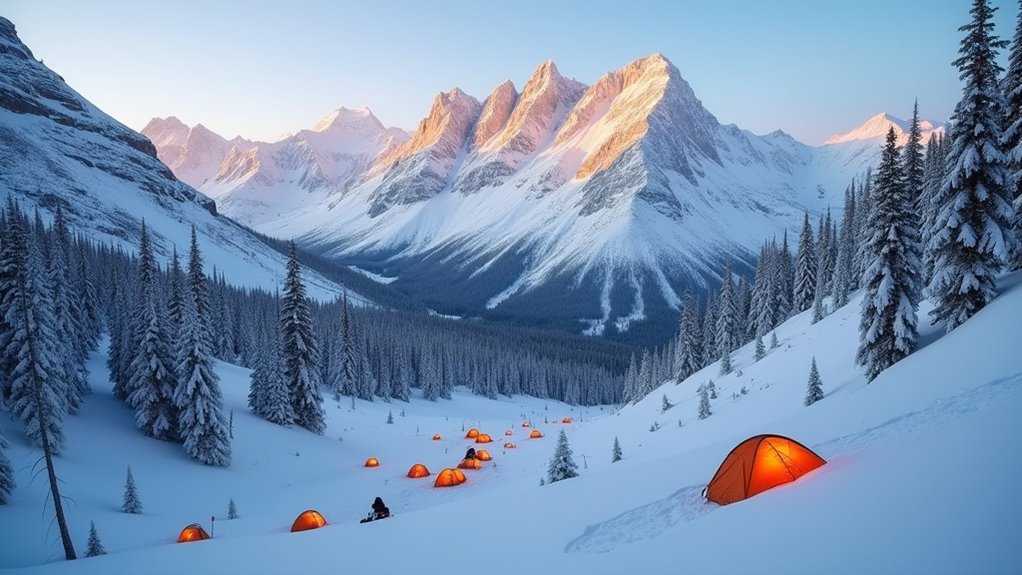
Keep warm while discovering twelve extraordinary winter camping destinations that reveal nature's frozen secrets most travelers never experience.
You’ve probably dreamed of escaping the crowded ski resorts and hotel prices that spike during winter months. There’s something raw and honest about pitching your tent when most people won’t venture outside their heated homes. Winter camping isn’t just about proving your toughness—it’s about accessing landscapes that transform completely under snow and ice. These twelve destinations won’t coddle you with luxury amenities, but they’ll show you what winter actually looks like when you strip away the commercialized version.
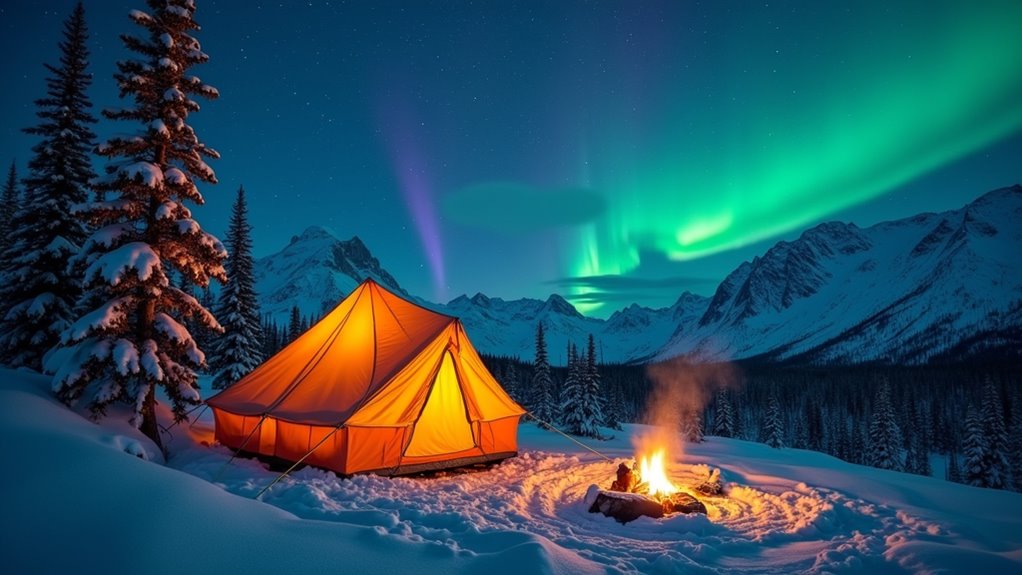
Why settle for ordinary winter camping when you can pitch your tent under one of nature’s most spectacular light shows? Denali National Park offers budget-conscious adventurers an unforgettable arctic experience where you’ll witness the aurora borealis dancing across pristine wilderness skies.
Experience nature’s ultimate light show while winter camping in Denali’s pristine wilderness – where aurora borealis transforms ordinary adventures into extraordinary arctic memories.
You’ll need proper cold-weather gear since temperatures drop well below freezing, but camping fees remain affordable year-round. The park’s backcountry permits cost just $5, making this world-class destination accessible to most budgets.
Plan your visit between September and March for prime aurora viewing. You’ll find the best camping spots away from Denali’s few light sources.
Bring a four-season tent, sleeping system rated for sub-zero temperatures, and extra batteries since cold drains power quickly. The payoff? You’ll experience Alaska’s raw beauty while northern lights illuminate your campsite.
If you prefer water-based adventures during warmer months, consider whether renting or buying a boat makes more sense for your fishing expeditions in Alaska’s pristine lakes and rivers.
While most winter destinations require choosing between stunning scenery or affordable camping, Banff National Park delivers both snow-capped mountain vistas and frozen lake landscapes without breaking your budget.
You’ll find frontcountry campgrounds like Tunnel Mountain Village II operating year-round with heated washrooms and cooking shelters – essential when temperatures drop to -30°C.
Lake Louise and Moraine Lake transform into frozen wonderlands perfect for snowshoeing and photography.
You can camp for just $22 CAD per night, making it incredibly affordable compared to nearby hotels charging $300+ nightly.
Pack a four-season tent and sleeping bag rated to -40°C.
Book campsites online since winter spots fill quickly.
The Icefields Parkway offers additional camping options with equally spectacular mountain views and budget-friendly rates.
For those seeking mobile winter adventures, caravan camping provides the flexibility to explore multiple locations while staying warm and comfortable in your own mobile basecamp.
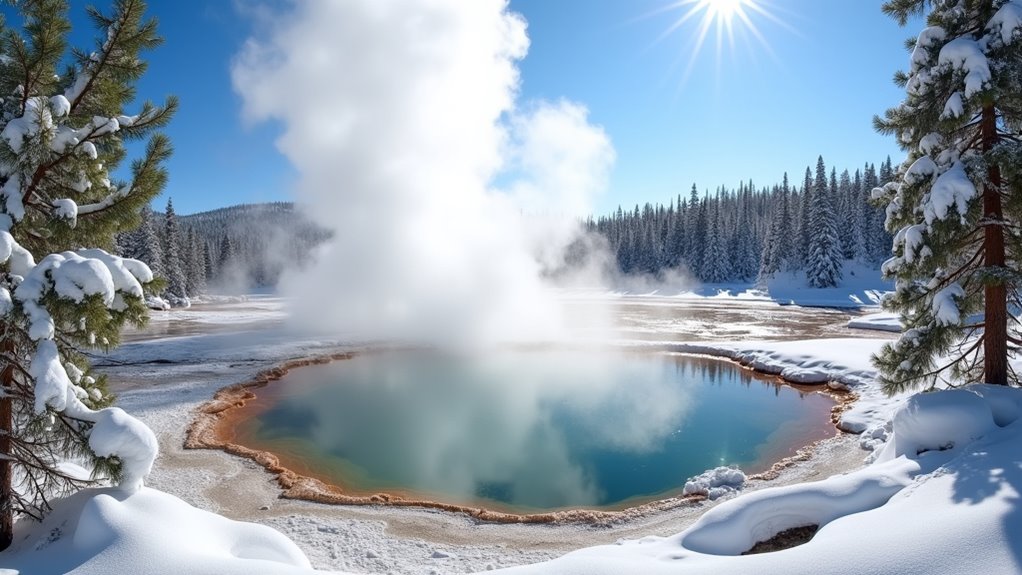
Where else can you witness geysers erupting against a backdrop of snow-covered pine trees while camping for under $20 per night? Yellowstone transforms into a magical winter wonderland where thermal features create dramatic contrasts against the frozen landscape.
You’ll find affordable camping at Madison Campground, one of the few winter-accessible sites. The park’s geothermal activity keeps some areas surprisingly warm, making winter camping more manageable than you’d expect.
Essential winter camping considerations:
The combination of steaming hot springs, spouting geysers, and snow-laden wilderness creates an unforgettable budget-friendly adventure that’s uniquely Yellowstone. For the truly adventurous, Yellowstone also offers access to some of the country’s premier glacier climbing experiences on its high-altitude frozen formations.
From Yellowstone’s thermal wonders, we head across the Atlantic to discover Norway’s spectacular fjords, where dramatic cliffs plunge into dark waters and free camping laws make arctic adventures surprisingly affordable.
Norway’s “right to roam” lets you pitch your tent almost anywhere for free, provided you’re 150 meters from houses. You’ll find incredible spots along Geirangerfjord and Nærøyfjord, where snow-capped peaks create stunning backdrops.
Pack a four-season tent and sleeping bag rated to -20°C. December through February brings polar nights in northern regions, perfect for aurora hunting.
Grocery costs run high, so bring non-perishables from home.
Access fjords via Bergen or Ålesund, then take ferries to remote areas. Many roads close in winter, making some locations accessible only by boat or ski.
To make winter camping more comfortable, focus on reducing pack weight by choosing lightweight versions of essential gear like sleeping bags, tents, and cooking equipment.

Beyond Norway’s famous fjords lies Iceland’s Westfjords, where you’ll discover some of Europe’s most isolated winter camping terrain without the crowds that flood Reykjavik’s Golden Circle. This rugged peninsula offers dramatic cliffs, pristine snowfields, and exceptional aurora viewing opportunities at a fraction of southern Iceland’s costs.
You’ll need proper cold-weather gear since temperatures drop well below freezing, but camping here saves hundreds compared to hotel stays. The region’s minimal light pollution creates perfect conditions for northern lights photography.
Essential considerations for Westfjords winter camping:
Wild camping remains legal and free throughout most areas. Before committing to this remote destination, determine your ideal camping style by evaluating your comfort level with extreme weather conditions and self-sufficiency requirements.
While most winter campers flock to Europe’s expensive ski resorts, Japan’s Alps offer an incredible alternative where you’ll encounter wild snow monkeys soaking in hot springs alongside your own budget-friendly camping adventure.
You’ll find affordable campgrounds throughout Nagano Prefecture, with sites like Shiga Kogen offering winter camping for under $15 nightly.
The famous Jigokudani Monkey Park lets you watch Japanese macaques bathing in natural hot springs – it’s pure magic against snowy backdrops.
Pack a four-season tent and quality sleeping system rated for subzero temperatures. Many campgrounds provide access to onsen (hot springs) where you can warm up after cold nights.
Don’t miss nearby ski resorts for day passes, but camping keeps costs manageable while you experience Japan’s winter wonderland firsthand.
Winter camping with your family creates the kind of unforgettable memories and adventure bonding experiences that simply can’t be replicated in hotels or resorts.
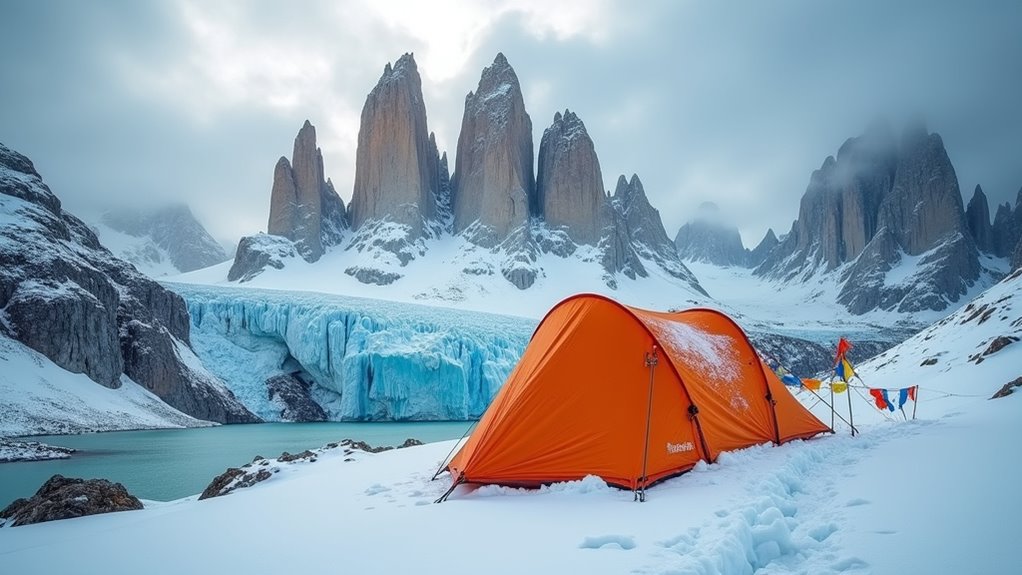
Trading Japan’s soaking monkeys for something completely different, Patagonia’s raw wilderness puts you face-to-face with some of Earth’s most dramatic landscapes without the crowds you’ll find in popular European destinations.
Chile’s Patagonia delivers intense winter camping where howling winds and glacier views test your skills. You’ll need serious cold-weather gear, but the payoff’s incredible – think massive ice fields stretching to horizons and complete solitude.
Budget-smart essentials for Patagonian winter camping:
For your morning caffeine fix in remote locations, consider bringing a portable espresso maker that can quickly prepare quality coffee without requiring bulky equipment.
Torres del Paine’s backcountry sites offer the most accessible glacier views, while experienced campers can tackle more remote areas for true wilderness solitude.
After Patagonia’s wind-battered peaks, Lapland’s snow-draped forests offer a completely different winter camping experience where you’ll camp under the polar night’s endless twilight alongside actual reindeer herds.
You’ll find temperatures dropping to -40°F, so invest in a four-season tent and proper sleeping system rated well below expected lows.
Budget-friendly camping spots include Urho Kekkonen National Park, where permits cost under $10.
You’ll encounter semi-wild reindeer that might investigate your campsite – don’t feed them.
The polar night lasts from December through January, creating surreal blue-hour lighting all day.
Pack extra batteries since cold drains them fast.
Melting snow for water takes significant fuel, so bring plenty.
Local supermarkets in Rovaniemi offer affordable resupply options before heading into the wilderness.
When setting up camp in this pristine wilderness, follow Leave No Trace principles to preserve the fragile Arctic ecosystem for future generations.
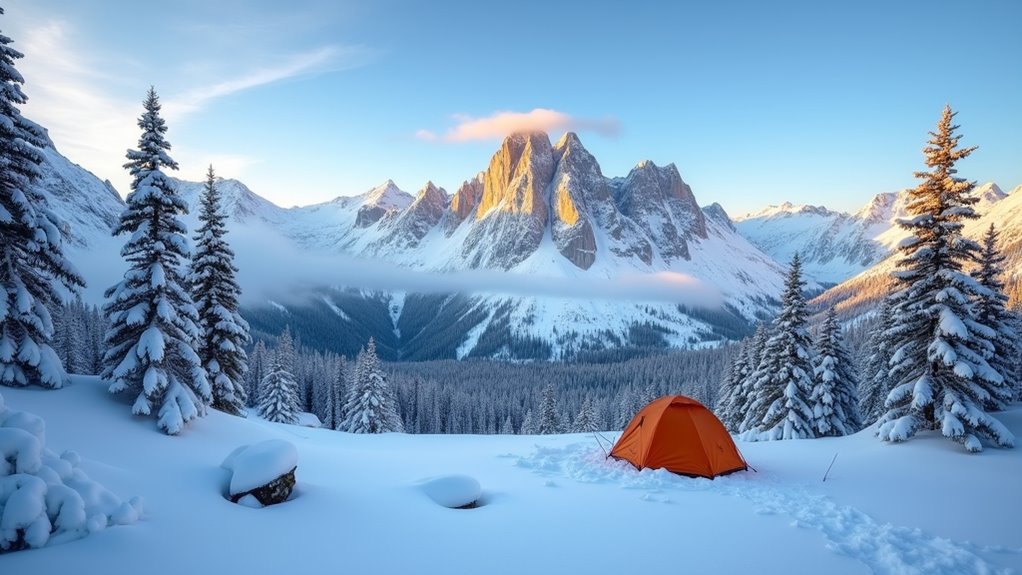
Three hundred miles of snow-covered trails await you in Rocky Mountain National Park, where winter camping means dealing with altitude, sudden weather changes, and some of the most spectacular mountain scenery in the lower 48.
You’ll face elevations above 8,000 feet, so acclimatization is vital before setting up camp.
Winter camping here requires serious preparation but won’t break your budget compared to resort destinations. Essential considerations include:
You’ll need backcountry permits and should inform rangers of your plans.
The park’s winter beauty—frozen lakes, snow-draped peaks, and crisp mountain air—rewards those prepared for high-altitude challenges. Research tent specifications thoroughly before your trip to ensure your shelter can withstand the extreme conditions and high winds common at these elevations.
When temperatures plummet to -40°F and daylight lasts just a few hours, the Siberian Taiga offers winter camping’s ultimate test in one of Earth’s most remote wilderness areas.
You’ll need serious cold-weather gear – a -40°F sleeping bag, insulated tent, and multiple layers are non-negotiable. Budget around $3,000 for proper equipment if you’re starting from scratch.
Access requires flying into cities like Yakutsk or Irkutsk, then arranging local transport. Book guided expeditions through Russian outfitters who handle permits and logistics – expect $200-400 daily including guides and meals.
The payoff? Pristine snow-covered forests stretching endlessly, incredible wildlife tracking opportunities, and bragging rights few possess.
Pack high-calorie foods, backup heating sources, and emergency communication devices. This isn’t beginner territory.
During the long winter nights, gather around a safe campfire to play campfire games that will keep spirits high and create memorable bonding experiences with your expedition team.
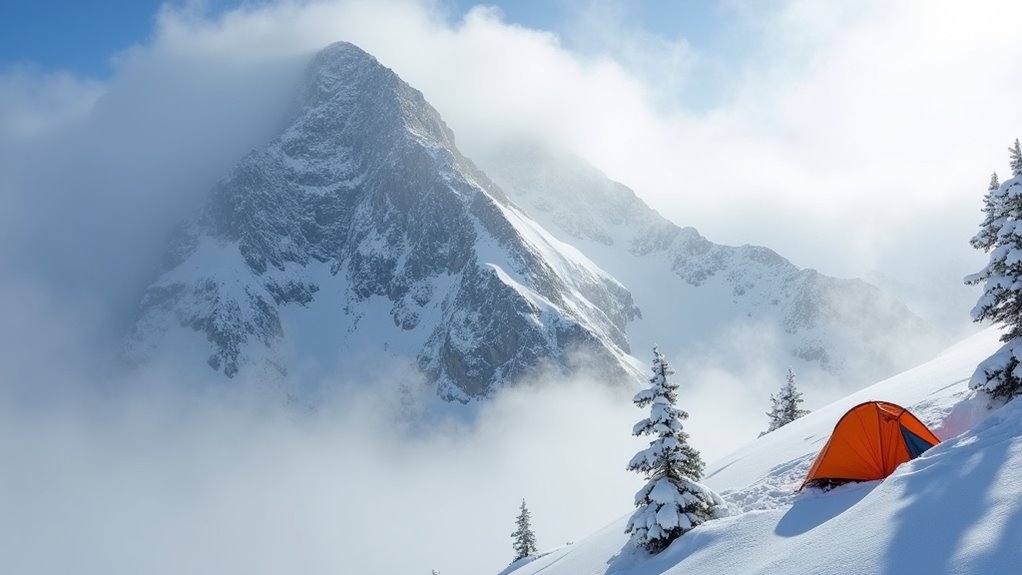
Why does Mount Washington attract winter campers despite holding the world record for the highest surface wind speed at 231 mph? You’ll find the answer lies in its unmatched challenge and accessibility.
Mount Washington’s deadly 231 mph winds don’t deter winter campers—they draw them seeking the ultimate accessible alpine challenge.
This 6,288-foot peak offers serious alpine conditions just hours from major cities, making it perfect for testing your winter skills without expensive international travel.
You’ll face three main challenges that define the Mount Washington experience:
You’ll need four-season gear and solid experience before attempting this mountain.
Many seasoned campers consider Mount Washington their ultimate East Coast winter proving ground.
Given the mountain’s reputation for dangerous conditions and steep terrain, winter campers should carry an avalanche transceiver as part of their essential safety equipment.
Located 800 miles from the North Pole, Svalbard presents winter camping’s most extreme frontier where you’ll need a rifle permit just to leave town. Polar bears roam freely here, making guided tours essential for safety.
You’ll camp in complete darkness during polar night (October-February), but March brings stunning aurora displays.
Budget around $3,000-5,000 for week-long expeditions including guides, gear, and flights from mainland Norway. Most operators provide specialized arctic tents and sleeping systems rated to -40°F.
You can’t camp independently—regulations require registered guides due to wildlife dangers.
The payoff? Unmatched solitude in Earth’s last wilderness. You’ll experience midnight sun in summer months, though winter’s endless night creates an otherworldly camping experience.
Book through Longyearbyen-based outfitters who handle permits and provide mandatory safety equipment. Pack essential camping gear suitable for extreme conditions, as standard equipment won’t survive Svalbard’s harsh arctic environment.
You’ve got your winter camping roadmap now – from Alaska’s aurora-painted skies to Siberia’s frozen forests. Each destination’s a different chapter in nature’s coldest storybook, and you don’t need to break the bank to experience them. Pack smart, layer up, and remember that the best gear is often what you already own. Winter camping isn’t just about surviving the cold; it’s about discovering you’re tougher than you thought.